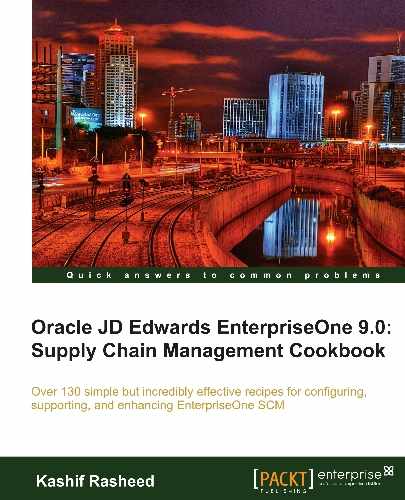The Printing Order processing options enable you to specify the range of status codes that you want the system to update when you print purchase orders, and whether you want the system to update the status codes.
You should set up the Processing Options for the Purchase Order Print Print (R43500) batch application in order to print the order details.
- Select Procurement and Subcontract Management | Daily Processing | Stock Based Purchasing, click the arrow on Print Purchase Order, and then click on Version.
- Select the XJDE0001 version, and copy the version via the menu option.

- On the Status Codes tab, specify the start of the status code range that you want the system to update in the Next Status Code From field. You must use a UDC (40/AT) that has been set up on the Order Activity Rules form for the order type and line type that you are using.
- Specify the end of the status code range that you want the system to update range in the Next Status Code Thru field. You must use a UDC (40/AT) that has been set up on the Order Activity Rules form for the order type and line type that you are using.
- Specify the Next Status Code Override that you want the system to update. The override status is another allowed step in updating status codes. You must enter a UDC (40/AT) that has been set up on the Order Activity Rules form for the order type and line type that you are using.
- Status Update specifies whether the system updates the status on an order. Normally, it is used to re-print purchase orders. If you don't want to update the next status, entering 1 will update the Purchase Order to next status as per the Order Activity Rule.
- On the Report Display tab, processing options enable you to select the information that the system includes in the report, such as quantities and amounts, exchange rates, global messages, and notes. All of these are optional and can be set up as per business needs.
- Specify whether the system prints the original quantity and amount or the open quantity and amount. If you leave this field blank, the system will print the original quantity and amount, and if you enter 1, the system will print only the open quantity.
- Exchange Rate Display specifies whether the system prints the exchange rate. Select 1 to print the exchange rate, or leave this field blank if you don't want to print the exchange rate.
- The Item Number Display processing option enables you to specify how the system displays item numbers. Enter 1 to print only the item number and enter 2 to print both the item number and the supplier's item number.
- Specify the Cross Reference Type that the system uses when printing a supplier's item number. The system stores the cross-reference information in the F4013 table. Cross-reference information is defined via UDCs that are set up in 41/DT.
- The Currency Processing option enables you to specify whether the system prints amounts in the domestic or foreign currency. If you select 1, the system prints amounts in the foreign currency, and if you leave this field blank then the system print amounts in the domestic currency.
After you enter orders, you can print them to review the orders and then send them to the appropriate suppliers. The system prints the orders in the language that is specified for the supplier in the supplier master table. You can also print orders to a work file, which enables you to customize the report. Before you customize a report, you must retrieve the appropriate address information and attachments or notes. You can print orders by batch so that you can review the orders and then send them to the appropriate suppliers. Use the processing options to specify which information prints on orders. You can print orders individually so you can review those orders before sending it to the appropriate suppliers. You can create print messages by using the Purchase Orders program (P4310). After you create a print message, you can assign it to an order or detail line during order entry. You use processin g options in Order Entry to specify whether attachments should be printed. You can assign an attachment to an order or to detail lines during order entry. Printing orders is usually a step in the sequence of processing orders. You set up these steps in Order Activity Rules (P40204) application. Once you print an order, you can have the system move the order to the next step in the process, or you can leave the order where it is so that you can print it again. You use processing options in Order Entry to specify whether the system updates status codes for orders after they print. You might want to print orders twice—once to review the orders and again to update the status codes. You can access these two versions of the print program through the processing options for Order Entry.
If you have set the processing options in Order Entry for the system to store purchase order information for Electronic Data Interchange (EDI), you can send the orders to the suppliers by using the EnterpriseOne Electronic Data Interchange system.
- Setting up purchase orders in Chapter 4,Understanding and Setting up Procurement
